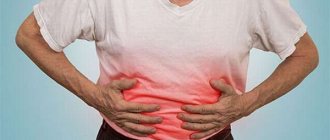Frequent or constant nausea during daylight hours is a sign of many pathologies of the human digestive system, and may also indicate general intoxication of the body. Especially if a person leads a healthy lifestyle, eats only biologically healthy foods, and does not have harmful addictions. A physiological phenomenon such as an attack of nausea is a reaction of muscle fibers in the upper and lower parts of the esophagus to irritation of the nerve endings located in the circumference. After they are irritated by neural signals from certain centers of the cerebral cortex, muscle spasm occurs and a gag reflex occurs. In a pathological condition of the gastrointestinal tract, food may not be released at all, but the person will always feel an uncomfortable feeling of nausea. Let's try to understand in as much detail as possible what the reasons for the origin of such an unpleasant sensation are and how to get rid of it in a short period of time.
Reasons - why do you constantly feel nauseous (but not vomit), what can cause nausea?
It is believed that sudden nausea is a multifactorial symptom that may indicate the presence of several diseases in the human body at once. It is not a prerequisite that these will be pathologies of the digestive tract.
Quite often, mild nausea, which is constant, is the first sign of diseases such as kidney and liver failure, intoxication of the body with vapors of toxic substances with a volatile molecular structure, the presence of which a person is not even aware of.
Based on many years of medical practice in the field of gastroenterology and toxicology, the following causes of constant nausea with frequent vomiting, or without such an attack, are identified.
Cholecystitis
An acute or chronic inflammatory process in the tissues of the gallbladder, which is characterized by a decrease in the functional activity of this organ of the digestive system. As a result, a significantly smaller volume of bile enters the duodenum, intended for the breakdown of fatty foods. The patient feels nauseous throughout the day, and the symptom is most severe after the next snack.
Poisoning
We are talking about a general toxic effect on the body. Labor activity at chemical, metallurgical, and coal enterprises leads to the fact that heavy metals and harmful substances accumulate in the liver tissue and over time begin to have a toxic effect. The factor of bad habits cannot be ignored.
People who frequently use alcohol, recreational drugs, or tobacco products may experience nausea for the same reason, but in a less severe form.
Helminthiasis
Tapeworms and roundworms, which are various types of worms, produce large amounts of toxins during their life processes. In this regard, a person loses his appetite, develops physical weakness, pale skin and constant nausea. In medical practice, there have been clinical cases where extensive helminthic infestation caused the patient to severely vomit with the release of parasites through the esophagus and oral cavity.
Gastritis
It is most often found in people suffering from the initial stage of this disease, when the disease has not yet become chronic and the body signals that severe irritation of the gastric mucosa is occurring, requiring urgent medical treatment. For this reason, you may feel suddenly nauseous, a spasm will occur inside the abdomen, and then everything will suddenly go away.
Pregnancy
This causal factor is unique to women. Nausea is diagnosed in the first trimester, when the fetus is actively developing and all body systems are being rebuilt to a new operating order. Physiological processes are accelerated, and to ensure intensive metabolism, a large concentration of hormones is required.
These secretions are responsible for the functioning of the organs of the digestive system, the functioning of the reproductive and central nervous systems. Therefore, nausea occurs against the background of a sharp surge in hormonal levels.
High blood pressure
Each person has their own working blood pressure. As soon as excessive compression of the walls of the great vessels occurs, the patient begins to experience not only a severe headache, but also a feeling of nausea. Quite often, this pathological condition develops into full-blown vomiting. In this case, the patient requires emergency medical care with intravenous administration of antispasmodics.
Disorders of the cerebral cortex
Certain brain centers are responsible for stable compression of muscle fibers in the upper and lower parts of the esophagus, including the gastrointestinal tract. If a person the day before suffered an intracranial injury, suffered from meningitis, or other serious infectious diseases, the development of which leads to damage to the main thinking organ, then in this case, nausea may occur due to its systemic dysfunction.
Disturbance of intestinal microflora
This organ of the human digestive system has its own stable balance and ratio of both beneficial and harmful microorganisms. After pathogenic bacteria, viruses or fungi enter its cavity, a strong immune reaction occurs, aimed at quickly clearing the intestinal tract of biologically hazardous agents. In this case, the patient not only experiences frequent nausea, but also severe vomiting associated with liquid diarrhea.
Hypothyroidism
This reason for which nausea may occur is not common, but still occurs in extensive medical practice. Moreover, this type of pathology is not so easy to diagnose. Especially if a person lives in a small locality where there is no expensive medical equipment. The disease is characterized by the fact that the thyroid tissue produces an insufficient amount of hormones involved in the digestion and absorption of food.
In this regard, a person who has relatively satisfactory tests suffers from frequent attacks of nausea, but cannot establish the true cause of his painful condition. Only an analysis of venous blood for hormone concentrations shows the clinical picture of the disease.
Pancreatitis and other diseases of the pancreas
This organ of the human digestive system plays a critical role in the stable functioning of the entire gastrointestinal tract. Therefore, if an inflammatory process occurs in its tissues, then all the food entering the stomach is not fully absorbed. In this regard, there is a natural rejection of undigested food particles back through the esophagus.
Quite often, the causes of constant nausea with bouts of vomiting are peptic ulcers. Single or multiple erosions irritate the gastric mucosa or its denser layers of epithelium. In this regard, the patient feels such an unpleasant feeling of spasm of the gastrointestinal tract.
Most common reasons
Loss of appetite and nausea after eating can be triggered by exacerbation of various chronic diseases, diseases of the gastrointestinal tract, cardiovascular and central nervous systems. The cause may also be the presence of harmful toxic substances in the body, endocrine disorders, mental disorders and even injuries.
Diseases and acute pathological conditions:
- Gastritis and peptic ulcer.
- Hepatitis and cholelithiasis.
- Pancreatitis.
- Hypothyroidism.
- Hypertension.
- Increased intracranial pressure.
- Appendicitis.
- Concussion.
- Food allergies.
- Food poisoning.
- Heart attack.
- The infection is viral or bacterial.
Serious diseases are listed; at the slightest suspicion, you should immediately consult a doctor. Characteristic signs, in addition to nausea and vomiting, are: acute pain, fever, increase or decrease in blood pressure, diarrhea, constipation, severe weakness - fainting.
Physiological reasons
The causes are not related to diseases and do not pose a threat to human health. It is enough to eliminate them to quickly get rid of unpleasant symptoms and restore a good appetite.
- Wrong diet. Constant overeating, especially in the evening, excessive consumption of unhealthy fried, fatty and spicy foods seriously overloads the stomach and pancreas. Fractional meals in small portions several times a day, high-quality products and healthy foods make it impossible to experience attacks of nausea.
- Fasting and unhealthy dieting. Poor nutrition and self-created deficiency of nutrients can cause weakness, poor appetite, and intestinal irritation. Increased interest in newfangled weight loss programs is fraught with serious consequences. Therefore, you should choose a diet only after consulting a specialist.
- Psychological reasons. Chronic fatigue syndrome, stress, and strong psycho-emotional stress cause a malfunction of the gastrointestinal tract. As a result of these disorders, a person has no appetite, he suffers from flatulence, constipation or diarrhea. The solution will be an established routine of the day and work week, providing for proper rest and 7 hours of sleep per day.
- Treatment with medications. When taking medications for a long time, the gastrointestinal tract has to digest and absorb a large number of chemical compounds. A serious load on the body provokes ailments - loss of appetite, nausea, drowsiness, weakness. They take medications in courses, taking breaks, giving the body time to recover. Or replace medications that negatively affect the gastrointestinal tract. This can be done with the permission of the attending physician.
Which doctor should I see and what tests should I undergo?
If you notice pathological symptoms associated with nausea, you should immediately seek help from a gastroenterologist. The doctor will conduct an initial examination, palpation of the abdomen, and then prescribe the following types of tests and diagnostic measures:
- blood from a finger for clinical examination and from a vein for the purpose of its biochemical study;
- feces for culture for pathogenic microflora, as well as helminth eggs;
- Ultrasound diagnostics of the abdominal organs;
- endoscopic examination of the health of the small and large intestines;
- gastroscopy of the stomach to identify ulcerative formations.
What to do - how to quickly relieve signs of nausea?
It is believed that treatment of nausea is not advisable, since it is not an independent disease. This is just one of the symptoms of the underlying disease. Despite this, there is one proven and universal way to relieve such an unpleasant sign of the disease. It is necessary to take a horizontal position. Namely, lie on your stomach. The right hand is clenched into a fist and placed under the peritoneum directly into the navel area.
You need to lie on the formed fist for 5-10 minutes and take sharp, deep breaths. In most cases, during the specified time, a reflex relaxation of the muscle fibers responsible for spasm and vomiting occurs. This method is indicated for everyone except pregnant women and children under 6 years of age.
The feeling of discomfort in the stomach is provoked by many factors. The cause of nausea after eating can be either harmless irritation of the mucous membrane of internal organs by spicy dishes, or an ulcerative process in the gastrointestinal tract (gastrointestinal tract). If the unpleasant feeling arose once and was not accompanied by painful sensations or severe vomiting, then there is nothing to worry about. In the case when you feel nauseous after almost every meal or in between meals, you need to contact a specialist and undergo examination. The attending physician will diagnose the problem, prescribe treatment and a rational diet.
Causes of nausea not related to illness
Nausea after eating does not only occur due to illness or poor quality food. The reasons can be very different.
Overwork and stress
Stress has a significant impact on digestive functions. During times of increased restlessness, anxiety:
- Heart rate increases;
- Blood vessels constrict;
- Muscles tense.
The digestive system also takes a defensive position. During such a period, it is better to take a temporary time-out and calm down.
When starting to eat, you need to focus only on it, forgetting about everything else. Focusing solely on food improves digestion and absorption of nutrients.
Not chewing food
Digestion begins in the mouth. Even before the first spoonful of food enters the mouth, the salivary glands are activated, secreting enzymes necessary for digestion.
Chewing is one of the important steps in the digestive process. Saliva softens and breaks down food, allowing it to move on to the next stage of processing in the stomach.
Unchewed food, entering the stomach, loads other organs involved in food processing. In addition to nausea, you may experience:
- Stomach ache;
- Bloating;
- Increased gas formation.
To avoid unpleasant symptoms, it is recommended to chew food at least 20 times.
Go to bed immediately after eating
Going straight to bed after a heavy dinner is bad for digestion. Lying down leads to indigestion and heartburn.
The last meal should be 2-3 hours before bedtime. That's how long it takes to digest.
Habit of drinking carbonated drinks
Carbonated drinks can put stress on your digestive tract. Symptoms of discomfort may occur after drinking 1 glass of carbonated drink. This is not necessarily lemonade, but also kvass and kombucha.
Causes of nausea after eating in women
The reasons why you feel sick after eating can be physiological and pathological. The former occur in a healthy body under the influence of external factors and usually go away on their own, while the latter indicate the presence of some pathology on the part of the internal organs, and not necessarily the digestive system.
Physiological reasons include:
- vigorous physical activity after eating food - within two hours after a meal it is not advisable to engage in sports, running, swimming;
- dysfunction of the vestibular apparatus not associated with diseases;
- presence of helminthic infestation;
- eating new, exotic foods (blue cheese, unusual fruits or vegetables, fish);
- binge eating;
- taking pills to promote rapid weight loss;
- pregnancy;
- state of panic, stress, anxiety;
- eating foods that have been spoiled or undercooked/fried.
The nausea that occurs in the situations described above goes away on its own within a few hours. In some cases, it can provoke a single vomiting, after which relief comes.
What diseases does it indicate?
Unfortunately, mild nausea may also indicate a pathological condition of the internal organs, which can sometimes even be life-threatening (for example, an atypical picture of myocardial infarction). Why do you feel sick after eating?
- Stomach upset. Nausea may be accompanied by heartburn and belching; symptoms most often occur after eating food that irritates the mucous membrane of the organ.
- Pancreatitis. Inflammation of the endocrine gland, which is located under the stomach and takes an active part in digestion. Accompanied by pain under the ribs on the left side, nausea.
- Hypothyroidism. Pathology of the thyroid gland, the characteristic symptoms of which are also drowsiness and a constant feeling of chills.
- Heart attack. In this case, nausea appears after eating and does not go away for a long time, sometimes accompanied by fatigue and shortness of breath.
- Arterial hypertension. A disease characterized by nausea, dizziness and a significant increase in blood pressure.
- Brain concussion. Nausea is present throughout the day, but after eating it intensifies, and vomiting may occur.
- Gallbladder or liver dysfunction. There is a bitterness in the mouth, pain in the hypochondrium on the right side.
If nausea is accompanied by severe vomiting, loss of consciousness, diarrhea, or the appearance of blood, you should immediately seek medical help, since this condition threatens a person’s life.
What foods help with nausea
Ginger
Traditionally, ginger is used for nausea. Gingerols and segaols are components of ginger that stimulate gastric emptying and may relieve feelings of nausea. Scientists have studied the effect of ginger on nausea and vomiting during pregnancy. Research has shown that ginger is more effective than placebo in reducing the severity of nausea and vomiting in pregnant women. The authors also found that ginger was effective in treating nausea caused by seasickness and chemotherapy. People can add ginger to broths or hot water.
Bouillon
Chicken or vegetable broth can be a good source of nutrients that are easy to digest. If a person is losing fluid due to vomiting, broths can replace lost fluid, salt and electrolytes.
Diet
For nausea and vomiting, you can use a diet that consists of:
- bananas
- rice
- applesauce
- toast
These products are easy to digest. Bananas are also a good source of energy and nutrients. They are high in potassium, which can replace electrolytes lost through vomiting. However, the diet does not provide enough nutrients for people in the long term. The diet may help for a short period, and people should add staple foods as soon as they start to feel better. It is also important to drink small sips of water frequently. Drinking large sips of water can upset an already uneasy stomach.
Dry products
Along with toast, other dry foods may be a good option for people who feel nauseous. Dry foods may include:
- saltine cracker
- pretzel
- oat and rice cakes
Cold food
People find it easier to eat cold food because it smells less than hot food. The smell of hot food can increase the feeling of nausea in some people. Good cold food options include:
- sandwich with a protein, such as peanut butter or egg salad
- crackers with a little cheese
- yogurt
- fruit icecream
Protein-rich foods
Protein helps the body produce enzymes that digest food. The body also uses protein to oxygenate the blood. Some studies suggest that eating more protein may relieve nausea and vomiting in pregnant women. Protein-rich foods:
- peanut butter
- fish
- turkey
- boiled egg
- plain, unsweetened yogurt
- baked tofu (not fried)
You can combine these foods with toast, rice or noodles.
People usually don't want to eat when they feel nauseous. However, small amounts of certain foods can relieve nausea and maintain energy levels.
Other tips that may help with nausea:
- sit up straight after eating
- avoid activity after eating
- watch TV, read a book, or talk while eating to distract yourself
- eat slowly to aid digestion
- eat small amounts throughout the day
- rinse your mouth or brush your teeth after eating to reduce feelings of nausea
Nausea in the morning, evening after eating
A feeling of nausea in the morning is often one of the first signs of an interesting situation in a girl, but it usually occurs regardless of food intake. In addition to pregnancy, morning discomfort may indicate hypertension, that is, high blood pressure, or, for example, alcohol intoxication.
Evening nausea is a sign of chronic gastrointestinal pathologies - ulcers, gastritis, dyskinesia. In some cases, this symptom may indicate inflammation of appendicitis. If everything is fine with the digestive organs, the problem may lie in the heart or blood vessels. The fact is that in the evening blood circulation gradually slows down, preparing the body for sleep. If the muscle tissue of the heart or blood vessels is too weak, blood stagnation occurs, which is accompanied by a feeling of nausea.
Why do you feel nauseous after eating fatty foods?
Fried foods containing large amounts of fat are a real test for the human digestive system. To digest it, you have to quickly mobilize the resources of the liver and pancreas - the two organs that suffer most from eating fatty foods.
A healthy body can withstand stress, but frequent intake of unhealthy food or the presence of concomitant pathologies leads to overload of organs. They stop secreting enzymes that are needed to break down what they eat, and the food “gets stuck” in the stomach, which in turn tries to get rid of unnecessary ballast, causing nausea and vomiting.
To protect the pancreas and liver from unnecessary overload, before eating fatty foods, you can take medications that help digest food.
Why do you feel sick after eating?
Nausea is an unpleasant feeling that can cause vomiting. Vomiting, in turn, is the body’s response, which ends with the emptying of the stomach from the food eaten.
Food is needed to survive. Like air and water, the main factor of life. Food:
- Provides the energy the body needs for daily activities;
- Maintains a constant supply of nutrients and calories.
The digestion process begins in the mouth, where food is chewed to make it easier to swallow. Then it enters through the esophagus into the stomach and further into the intestines.
Stomach juice, digestive juices, break down what you eat, extracting nutrients and sending waste to the colon for elimination from the body.
Nausea usually has a protective effect because it prevents harmful substances from entering the body. Therefore, any problems that arise during the passage of food through the digestive tract can lead to its occurrence.
Symptoms often appear in the upper abdomen, where the first processes of digestion begin. Sometimes the body reacts to emerging problems by forcibly emptying the stomach - vomiting.
Nausea and heaviness in the stomach
Nausea may be accompanied by heaviness in the stomach.
If the feeling of heaviness predominates, then most likely the reason is the following:
- Binge eating. Too large portions of food lead to stretching of the stomach walls. It is better to eat more often, but little by little;
- Insufficient chewing. Poorly chopped food is more difficult to digest, and therefore the body has to expend more resources;
- Irregular meals and long breaks between meals;
- Dishes that irritate the gastric mucosa (spicy, salty, cold, hot).
What you need to know about the disease
There are several main categories that include stomach pain and nausea. Separation is carried out on the basis of the reasons that gave rise to discomfort. These include:
- infectious diseases,
- chronic diseases,
- ailments due to overeating and poor nutrition,
- discomfort caused by female physiology.
Once you understand what type of stomach problem you have, you can decide on treatment and, if necessary, choose a specialist. One of the most striking markers, thanks to which you can figure out what caused the illness, is pain. Many people cannot concentrate and identify the source of discomfort, relying on a short “I have a stomach ache,” but this is the wrong approach. Of course, it is unreasonable to demand from a child an exact answer where exactly he experiences discomfort, but an adult should be able to explain this kind of thing.
The first step is to determine where exactly the pain node is located. If it is in the upper abdomen, then you have a stomach problem. During menstruation, women may experience severe cramping in the lower area, closer to the uterus. Also, spasms around the navel indicate a disease of the small intestine. The ulcer is “responsible” for the middle part of the abdomen, and if unpleasant sensations come from the back, in the hypochondrium, then your attention is drawn to the pancreas.
Types of pain signals
Acute pain, as if you are being cut with a knife, is a serious symptom that indicates the presence of an ulcer or worsened gastritis. If discomfort has several stages - it can be tolerated, cannot be abstracted, causes tears - and these stages replace each other over time, then it is attributed to a spasmodic nature.
Colic, which prevents you from straightening up and forces you to fold in half, is a symptom of overeating or excess gases in the body. Heaviness in the stomach, as if you had swallowed a stone, occurs with dyspepsia.
Causes of occurrence in older women
At an older age, the body weakens and is more often susceptible to various diseases. Pathologies of the gastrointestinal tract, cardiovascular system and neurological problems are usually encountered.
With age, the condition of the epithelium of the mucous membrane of the stomach and intestines worsens, so the feeling of nausea in elderly women may occur due to:
- minor irritation;
- stress;
- pressure rise;
- failure in daily routine;
- unusual nutrition.
Indigestion in the elderly should not be ignored, since it can also be a manifestation of a stroke, cancer, heart attack or serious poisoning.
Accompanied by pain syndrome
Nausea, which is accompanied by pain, always indicates illness. Patients with such symptoms definitely need to be examined by a doctor and treated. The localization of pain indicates the diseased organ.
- Small of the back. Back pain, especially on the side of the spine, accompanied by nausea indicates problems of the urinary system (pyelonephritis, renal colic, glomerulonephritis).
- Epigastrium (stomach area). Pathological process in the upper gastrointestinal tract (ulcer, gastritis, bleeding).
- Head. Headache along with nausea can be a manifestation of stroke, migraine, hypertension.
- On the right under the ribs - hepatic colic, cholecystitis.
- Left hypochondrium – inflammation of the pancreas.
Nausea, dizziness and weakness
Nausea with dizziness and weakness occurs in women before or during menstrual bleeding. This is due to a sharp change in hormonal levels, as well as blood loss, which leads to physiological anemia (decrease in the amount of hemoglobin in the blood). In addition, such symptoms can be an early sign of pregnancy if they occur against the background of a delay in menstruation.
If dizziness and weakness develop into loss of consciousness, this indicates hypotension - low blood pressure. This condition requires correction with medications.
Provoking factors may be:
- insufficient iron intake;
- rare exposure to fresh air;
- excessive loads, overwork;
- insufficient amount of sleep;
- stress;
- hypovitaminosis.
If symptoms appear regularly, regardless of the menstrual cycle, the patient is at risk of having a brain tumor.
How can women get rid of the disease?
To get rid of unpleasant sensations, you need to identify their cause, on which treatment will depend.
- Gastritis. It is necessary to eat a diet that excludes dishes that can irritate the gastric mucosa (spicy, salty, hot, cold).
- Ulcer. A diet similar to that prescribed for gastritis is required, and in some cases, surgery.
- Anemia. It is recommended to increase the amount of meat, liver and apples in the diet. You can take medications containing iron.
- Problems with the liver and pancreas. Be sure to cross out fried and fatty foods from the menu, take tablets that improve digestion and protect these organs.
- Pregnancy. During pregnancy, they try to combat nausea and vomiting without prescribing medications. To reduce discomfort, you need to eat right, avoid strong odors and rest more often.
Nausea after eating mainly indicates the presence of acute or chronic ailments in the body. The factors causing this condition may be of a psychological nature, as well as a phenomenon of a post-traumatic state. Let's take a closer look at the causes of nausea.
Drinking decoctions
The simplest recipes:
- Camomile tea. This tea will help get rid of unpleasant symptoms for both children and adults. To do this, you need to buy chamomile flowers at the pharmacy and brew them at the rate of two teaspoons of the plant per 250 ml of boiling water. The decoction should be infused for 30-40 minutes, taken 3-4 times a day. This will not only help get rid of unpleasant urges, but also soothe irritated intestines.
- Rice water. This recipe is also suitable for children and adults, but there is one thing: if there is also constipation with nausea and vomiting, then it is better not to use it, since such a decoction strengthens it even more, but it helps well with diarrhea. In order to prepare such a remedy, you need rice (100 g) and 600 ml of water. Cook the cereal over medium heat until it is completely boiled, and then strain through cheesecloth. Drink 2 tsp. during the day.
- Herbal collection. Various herbs have always been used in medicine; they will help in this case too. In order to prepare the infusion, you need 8 tsp. dry or fresh mint and 2 tsp. centaury. Pour the herbs with hot water, about 250 ml, and then leave for an hour in a dark place. Strain through cheesecloth and drink three times a day. Give children half a glass of this decoction.
- Ginger infusion. Oddly enough, but such a spicy product as ginger can help with vomiting and nausea. For this you need fresh root; powdered root will not work. We rinse it and then finely (we only need 10 g), and then fill it with 250 ml of boiling water and let it brew for half an hour. You need to take this infusion throughout the day, but in small quantities. Every hour 20 ml. This remedy is best given only to adults or adolescents; it is not recommended for small children.
- Dill decoction. This recipe is suitable for those who, in addition to nausea and vomiting, also have a symptom such as constipation. Dill infusion is made either from fresh dill, or you can buy its seeds at the pharmacy. Add 20 g of fresh or pharmaceutical dill to a small saucepan, add 250 ml of hot water and cook for 10 minutes, then turn off and let cool, then strain through cheesecloth and drink. You need to take half a glass three times a day. Small children have a quarter glass.
Nausea after eating - what is it?
This is a kind of protective reaction of the body. It occurs as a result of irritation of the digestive system.
- The sector of the brain responsible for the vomiting process receives a signal about problems in the body associated with poor-quality food or microbes.
- The salivary glands instantly activate their work, and the body prepares to cleanse the stomach.
- Vomiting clears the stomach, and the person’s well-being begins to improve.
In this case, we are talking about nausea associated with overeating or abuse of fatty, low-quality food.
Nausea is often localized slightly below the solar plexus and is accompanied by a feeling of fullness in the stomach. The patient may feel that food has accumulated in the throat and will be thrown out any minute.
About nausea on video
Main causes of nausea after eating
Nausea and vomiting after eating are not always associated with overeating. They often talk about certain diseases.
| Causes of nausea | More symptoms | What to do? |
| 1. Gastrointestinal diseases. This includes: |
- gastritis, stomach ulcer
- inner ear problems;
- labyrinthitis;
- vestibulopathy;
- Meniere's disease.
The emergency doctor must do an ECG, measure blood pressure, and listen to the heartbeat to determine the presence of a heart attack.
There are a number of other diseases whose symptoms are associated with the appearance of nausea after eating.
How to protect yourself from nausea
Very often we ourselves are to blame for our troubles. We eat on the go, and sometimes we are too lazy to wash our fruit, so we wipe it on our clothes and think that’s enough. We also sometimes feel sorry for throwing away a slightly spoiled vegetable, and we simply cut off the bad part and then add the leftovers to the soup. Also, in an effort to save money, we buy low-quality products or those that will soon expire. All these nuances lead to nausea, and subsequently vomiting.
So how can you protect yourself? It’s very simple: always wash vegetables and fruits before eating, you don’t need to treat them with anything to make them cleaner, just hold them under running water.
Also check the expiration date on the package and do not take it if there is one day left before the end. Try to eat 5 times a day, but in small portions. In addition, the menu must include soups and cereals. Give yourself fasting days. The main thing is that you don’t need to eat at night and teach your children to do it. We should not forget about physical exercises; it is better to do them 2 hours after eating. Eat less fatty and spicy foods, and then nausea and vomiting will not be a problem for you and your loved ones. These are the basic tips on what to eat when you feel sick.
How to avoid nausea after eating: prevention
Prevention of the development of nausea should be aimed at eliminating the causes of its occurrence. The rules of a healthy lifestyle often help to avoid this unpleasant phenomenon.
- eat small meals every 4 hours;
- drink enough fluid for the normal functioning of the stomach and intestines;
- drink unsweetened drinks, give preference to pure or mineral water without gas. Green tea and compotes are useful;
- After lunch, walk a little, take a walk in the fresh air. Provide the body with regular exercise to help stabilize metabolism;
- give up irritating foods (spices, flavorings, fried foods);
- reduce the consumption of flour products;
- to refuse from bad habits;
- if the cause of discomfort is the vestibular system, do not eat before moving on vehicles;
- Before taking the drug, carefully read the instructions; a side effect may be nausea;
- during pregnancy, minimize stress factors, fatigue, and physical activity;
- be careful in your movements to avoid bruises and injuries;
- if you have an allergic reaction to certain products or external irritants, avoid them if possible;
- Maintain personal hygiene, regularly ventilate your living space and workplace;
- Be sure to watch your weight and don’t overeat.
| Discomfort begins during or after eating. The condition is accompanied by a feeling of heaviness in the epigastrium, sour belching, a feeling of heartburn, and pain in the epigastrium. Vomiting is possible , occurring in the evening a certain time after eating. | You should undergo examination by a gastroenterologist: ultrasound, gastroscopy, take a blood test, do tests for antibodies and for a certain type of bacteria. Depending on the cause of the disease, a therapeutic course of treatment and a special diet are prescribed. | |
| Belching , a feeling of a lump in the throat, pain in the pit of the stomach are recorded. Discomfort appears in the evening and in the morning when you are hungry. | The condition is alleviated with special diets and therapy in order to stabilize the acid balance. |
| The disease is accompanied by swelling in the abdominal cavity, piercing, binding pain, moving to the right side under the ribs, to the spine, diarrhea, and sudden weight loss. | They do an ultrasound, tests for sugar and enzymes, and determine inflammatory foci, if any. Therapeutic therapy is carried out using enzyme preparations and antibiotics, and a special diet is prescribed. |
| With this disease, there is pain in the ribs on the right side, a metallic taste in the mouth, and flatulence. The symptom also bothers you while eating. | Diagnosed using ultrasound. Drug therapy, sometimes surgery is necessary. |
| 2. Violation of the vestibular apparatus | Accompanied by dizziness, tinnitus, vomiting, and possible nystagmus (involuntary movements of the eyes). | An otolaryngologist and a neurologist deal with the disease. Possible diseases include: |
| 3. Pregnancy | Toxicosis during pregnancy can manifest itself in early or late stages. Discomfort occurs most often in the morning; the pregnant woman feels a particular dislike for certain odors, which can cause vomiting. If you are severely unwell, you should be treated in a hospital setting. Late toxicosis is accompanied by vomiting, swelling, and high blood pressure. This condition is proof that the nervous and urinary systems are damaged. An examination by a gynecologist is necessary, who will prescribe the necessary treatment after the examination. | Early toxicosis can be overcome by including fruits, nuts, crackers, and tea with soothing herbs in the morning diet. In the early and late stages, overexertion, stress, and physical activity should be excluded. In case of severe discomfort, consultation with a gynecologist is necessary. |
| 4.Intoxication. Intestinal infections | In case of intoxication, the cloudiness begins some time after eating. The process is resolved by vomiting. The victim feels pain in the upper abdomen, general weakness, diarrhea, and the temperature rises. In severe intoxication, spasms and fainting occur. | Drug therapy is administered depending on the disease. For example, for rotavirus, Enterofuril, Smecta, antipyretic and antiviral drugs are prescribed. Regidron is given against dehydration. If vomiting does not stop, bile is detected in the stool, signs of severe dehydration are noticeable, it is necessary to urgently call an ambulance. |
| 5.Dietary disorders | Unpleasant sensations can come from an improperly organized diet, when the breaks between meals are very long. Nausea intensifies when a person eats sweets and baked goods. Nausea can also occur during extreme diets, when the patient has sharply reduced food portions or spends fasting days without eating. | A clear diet is required. Eat food in small portions, but over a short period of time. Food should be consumed in a crushed state, and fasting days should be carried out after consultation with a nutritionist. |
| 6. Helminthiasis | Nausea is sometimes caused by helminth infection. Helminthic infestation is often disguised as gastrointestinal tract diseases or acute respiratory viral infections. The patient may have itching of the anus, anemia, and skin rashes. | You need to contact an infectious disease specialist, conduct laboratory tests, and strictly follow the doctor’s individual instructions. |
| 7. Heart attack | The patient feels nausea, possible vomiting, pain in the epigastric region, diarrhea, abdominal tension. Anemia and lack of oxygen are recorded The patient has difficulty breathing. | If the patient is in the age group of 50 years and above, smokes, or is overweight, with such symptoms it is necessary to immediately call an ambulance. |
| 8. Acute pyelonephritis | In the case of this disease, nausea appears in both hungry and well-fed states, often ending in vomiting. The disease is expressed by a temperature of up to 40 degrees, abnormal sweating, weakness, dull pain in the lower back, and problems with urination. | The correct solution would be inpatient treatment. Specific urine and blood tests and ultrasound of the urinary organs are performed. The urologist must prescribe medication and diet. |
| 9. Excessive dosage of medications, caffeine | Almost all medications can cause side effects such as nausea. The question is the individual susceptibility of the drug. With an overdose of caffeine, reflex twitching of the limbs is observed. | If nausea occurs after taking a certain drug, you should read the instructions and consult your doctor. If necessary, replace or discard the drug. In case of caffeine overdose, first aid is provided: access to fresh air is provided, the stomach is washed, and the victim is given absorbent and enveloping agents. |
| 10. Appendicitis | An unpleasant feeling appears while eating. Pain in the initial phase is felt around the navel, then in the right iliac zone (the location of appendicitis). The pain intensifies with movement. The abdominal muscles are tense, the pulse is rapid, the temperature is elevated. | You need to call an ambulance immediately to avoid the development of peritonitis. The patient should be at rest. You should not give him analgesics or apply a warm heating pad to the problem area. |
| 11. Migraine | A migraine is accompanied by a headache on one side of the head, dizziness, numbness or tingling of the face, sensitivity to light and noise, a feeling of coldness and pale skin. | If a headache occurs, you should ensure silence and calm. In case of severe attacks, drug therapy is carried out, painkillers, triptans, ergotamines, opiates, drugs for nausea and vomiting, anticonvulsants, and antidepressants are prescribed. |
| 12. Painful menstruation | Before menstruation, pain appears in the lower abdomen, sacrum and lower back. The menstrual cycle is accompanied by cramping pain, which is accompanied by general malaise (vomiting, nausea, dizziness and headache). | It is recommended to avoid physical activity, take soothing herbal infusions, and avoid stressful situations. For severe pain, analgesics and antispasmodics, for example, No-shpa, will help. |
| 13. Hypertension | It is accompanied by severe headaches, dizziness, impaired vision and hearing, shortness of breath and nausea, increased heart rate, and chest compressions. | Medicines and preventive measures prescribed by a doctor after a complete examination of the patient will help lower blood pressure. For diagnostic purposes, an ECG, ultrasound of the kidneys and renal arteries are performed, and a laboratory examination of urine and blood is prescribed. |
| 14. Glaucoma | Narrowing of the viewing angle, dizziness and headaches, eye pain, nausea and vomiting, hemorrhage in the eye, photophobia. | You should consult an ophthalmologist for advice. |
| 15. Concussion | During a head injury, a person loses consciousness . Later, the patient complains of headache, pain, dizziness, nausea and vomiting. Tinnitus appears | The main treatment for the disease is healthy sleep and rest. For severe headaches, vomiting, etc., the doctor prescribes appropriate treatment. |
What diseases are characterized by the symptom of heaviness in the stomach?
Heaviness in the stomach is a sign of gastritis.
Of course, not only poor nutrition, stress and pregnancy can cause heaviness in the epigastrium. Sometimes this can be a signal of the development of serious pathological conditions and illnesses. Which ones?
Gastritis. It is characterized by the appearance of an inflammatory process on the inner wall of the stomach. The causes of the disease are different. These include:
- poor nutrition;
- excess or lack of hydrochloric acid in the stomach. In other words, increased or decreased acidity;
- infection with Helicobacter Pylori, a microorganism that can actively develop on the gastric mucosa and thereby irritate it.
Manifestations of gastritis include:
- heaviness in the stomach;
- frequently occurring sharp or dull pain in the epigastric region;
- nausea, especially after eating;
- unpleasant belching, sometimes vomiting.











